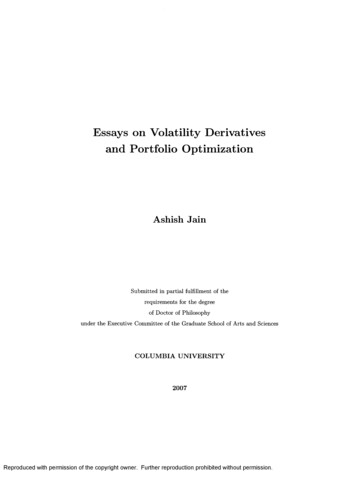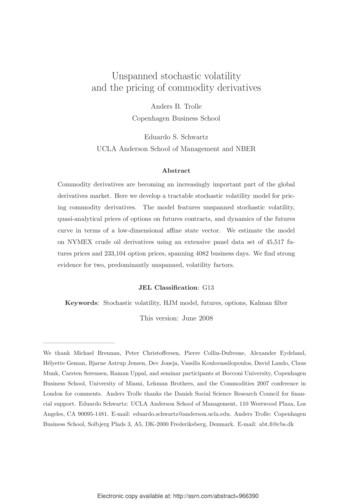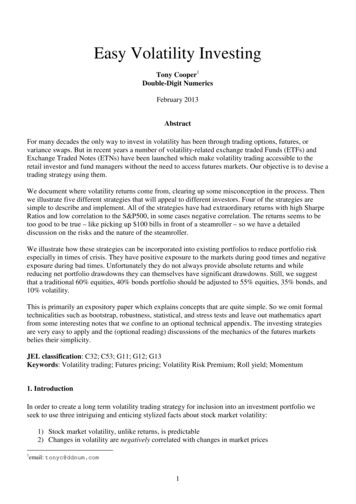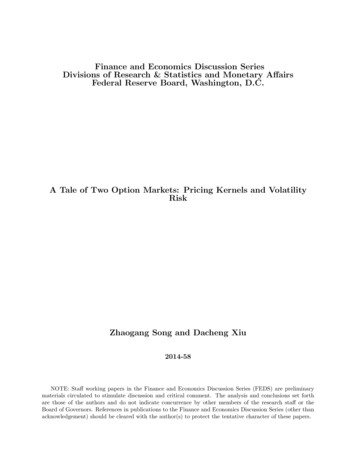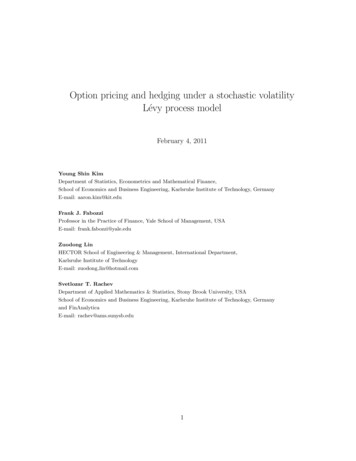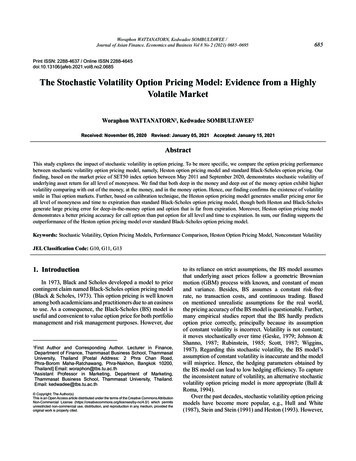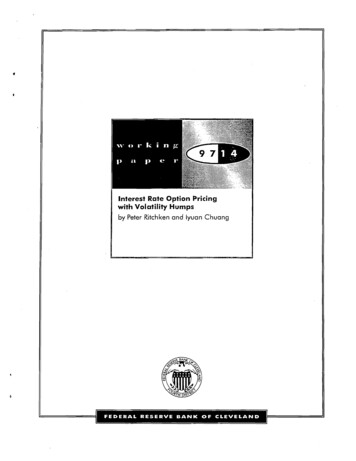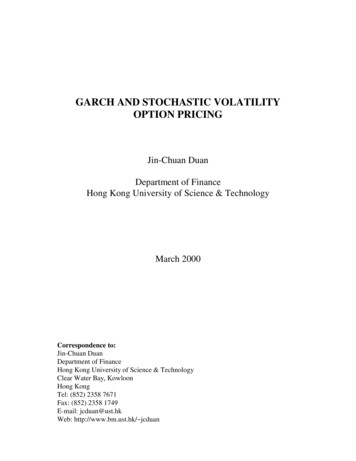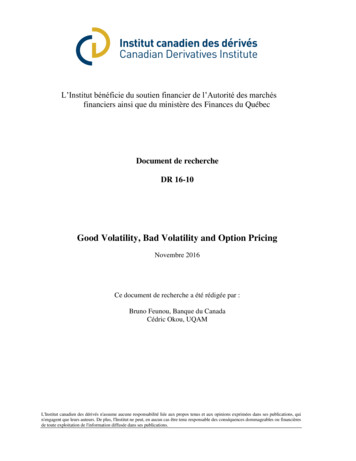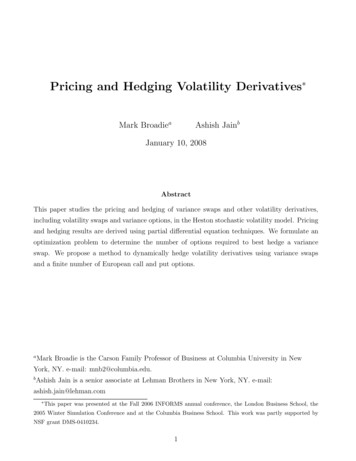
Transcription
Pricing and Hedging Volatility Derivatives Mark BroadieaAshish JainbJanuary 10, 2008AbstractThis paper studies the pricing and hedging of variance swaps and other volatility derivatives,including volatility swaps and variance options, in the Heston stochastic volatility model. Pricingand hedging results are derived using partial differential equation techniques. We formulate anoptimization problem to determine the number of options required to best hedge a varianceswap. We propose a method to dynamically hedge volatility derivatives using variance swapsand a finite number of European call and put options.aMark Broadie is the Carson Family Professor of Business at Columbia University in NewYork, NY. e-mail: mnb2@columbia.edu.bAshish Jain is a senior associate at Lehman Brothers in New York, NY. e-mail:ashish.jain@lehman.com This paper was presented at the Fall 2006 INFORMS annual conference, the London Business School, the2005 Winter Simulation Conference and at the Columbia Business School. This work was partly supported byNSF grant DMS-0410234.1
1IntroductionVolatility derivatives are securities whose payoff depends on the realized variance of an underlying asset or an index return. Realized variance is the variance of the underlying asset’s returnover the life of the volatility derivative. A variance swap has a payoff which is a linear functionof the realized variance, a volatility swap has a payoff which is a concave function of the realizedvariance and a variance call option’s payoff is a convex function of the realized variance. Weprovide definitions of various volatility derivatives in Section 2.In this paper we propose a methodology for hedging volatility swaps and variance options usingvariance swaps. Since the price of both variance swaps and volatility swaps depend on the realized variance of the underlying asset, there must be a relationship between their prices to avoidarbitrage. Since variance swaps can be priced and hedged using actively traded European calland put options, by exploiting the no-arbitrage relationship between volatility derivatives andvariance swaps we can price and hedge volatility derivatives.The volatility of asset prices is an indispensable input in both pricing options and in risk management. Through the introduction of volatility derivatives, volatility is now, in effect, a tradablemarket instrument. Previously traders would use a delta-hedged option position as a means totrade volatility. However, this does not provide a pure volatility exposure since the return alsodepends on the underlying stock price. Variance and volatility swaps provide pure exposure tovolatility and have become quite popular in the market. Three different groups of traders haveemerged: directional traders, spread traders and volatility hedgers. Directional traders speculate on the future level of volatility, while spread traders bet on the difference between realizedand implied volatility. In contrast, a volatility hedger typically covers short volatility positions.For example, life insurance companies now offer many products with guaranteed benefits (e.g.,variable annuities or with-profits funds) and these expose them to short volatility positions thatmay be offset by using variance swaps. Variance and volatility swaps capture the volatility of theunderlying asset over a specified time period and are effective hedging instruments for volatilityexposure. Based on the demand from volatility traders, the market in volatility and varianceswaps has developed rapidly over the last few years and is expected to grow more in the future.Estimating total trading volume is problematic, as with any OTC market, but recent estimatesfor daily trading volume on indices are in the region of 30–35 million notional. Hence the pricingand hedging of these derivatives have become an important research problem in academia andindustry.1
Building on the work of Neuberger (1994), Demeterfi, Derman, Kamal and Zou (1999) examinedproperties of variance and volatility swaps. They showed that variance swaps can be replicatedby a static position in European call and put options of all strikes and a dynamic trading strategyin the underlying asset. Brockhaus and Long (2000) provided an analytical approximation forthe pricing of volatility swaps. Javaheri, Wilmott and Haug (2002) discussed the valuation ofvolatility swaps in the GARCH(1,1) stochastic volatility model. They used a partial differentialequation approach to determine the first two moments of the realized variance and then useda convexity approximation approximation to price the volatility swaps. Lipton (2000) pricedvolatility swaps using a PDE approach. Little and Pant (2001) developed a finite differencemethod for the valuation of variance swaps in the case of discrete sampling in an extendedBlack-Scholes framework. Detemple and Osakwe (2000) priced European and American optionson the terminal value of volatility when volatility follows a diffusion process. Carr, Geman,Madan and Yor (2005) priced options on realized variance by directly modeling the quadraticvariation of underlying process using a Lévy process. Carr and Lee (2005) priced arbitrary payoffs of realized variance provided a zero correlation assumption between stock price process andvariance process. Broadie and Jain (2007) show that the convexity correction approximationdoesn’t provide a good estimate of fair volatility strikes in the Heston stochastic volatility andthe Merton jump-diffusion models.In this paper we price variance and volatility swaps when the variance process is a continuousdiffusion given by the Heston stochastic volatility model. We compute fair volatility strikes andprice variance options by deriving a partial differential equation that must be satisfied by volatility derivatives. We compute the risk management parameters (greeks) of volatility derivativesby solving a series of partial differential equations. Independently, Sepp (2006) priced optionson realized variance in the Heston stochastic volatility model by solving a partial differentialequation. We present a numerical method to determine the number of options required to hedgea variance swap. We propose a method to dynamically hedge volatility derivatives using varianceswaps and a finite number of European call and put options.The rest of the paper is organized as follows. We begin by briefly introducing volatility derivativesin Section 2. In Section 3 we present the pricing of volatility swaps and the variance options usinga partial differential equation approach in the Heston stochastic volatility model. In Section 4we present the computation of greeks of volatility derivatives in the Heston stochastic volatilitymodel. In Section 5 we present an optimization approach to hedge variance swaps using a finite2
number of options. We also present a dynamic approach to hedge volatility swaps using varianceswaps. Concluding remarks are given in Section 6.2Volatility DerivativesVolatility and variance swaps are forward contracts in which one counterparty agrees to pay theother a notional amount, N, times the difference between a fixed level and a realized level ofvolatility and variance, respectively. The fixed level is called the variance strike for varianceswaps and the volatility strike for volatility swaps. Realized variance is determined by the variance of the asset’s return over the life of the swap.The variance swap payoff is defined as(Vd (0, n, T ) K) Nwhere Vd (0, n, T ) is the realized variance of stock return (defined below) over the life of thecontract, [0, T ], where n is the number of sampling dates, the subscript d is used to emphasize that the variance is computed discretely (i.e., with a finite number of sampling dates, n),K is the variance strike, and N is the notional amount of the swap in dollars. The holder ofa variance swap at expiration receives N dollars for every unit by which the stock’s realizedvariance Vd (0, n, T ) exceeds the variance strike K. The variance strike is quoted in units ofvolatility squared, e.g., (20%)2 . For example, suppose an investor takes a long position in avariance swap with strike (20%)2 0.04 and a notional of one million dollars. If, over the lifeof the contract, the realized variance is (25%)2 0.0625, the investor would make a profit of(0.0625 0.04) 1,000,000 22,500.The volatility swap payoff is defined as(where Vd (0, n, T ) K) N Vd (0, n, T ) is the realized stock volatility (quoted in annual terms as defined below) overthe life of the contract, where n is the number of sampling dates, K is the volatility strike, andN is the notional amount of the swap in dollars. The volatility strike, K, is typically quotedin units of percent, e.g., 20%. An investor who is long a volatility swap with strike 20% and anotional of one millon dollars would make a profit of (0.25 0.2) 1,000,000 50,000 in the3
previous example.The procedure for calculating realized volatility and variance is specified in the derivative contractand includes details about the source and observation frequency of the price of the underlyingasset, the annualization factor to be used in moving to an annualized volatility and the methodof calculating the variance. Let 0 t0 t1 . tn T be a partition of the time interval[0, T ] into n equal segments of length t, i.e., ti iT /n for each i 0, 1, ., n. Most tradedcontracts define realized variance to be 2n 1 Si 1AF lnVd (0, n, T ) n 1 i 0Si(1)for a swap covering n return observations. Here Si is the price of the asset at the ith observationtime ti and AF is the annualization factor, e.g., 252 ( n/T ) if the maturity of the swap, T , isone year with daily sampling. This definition of realized variance differs from the usual samplevariance because the sample average is not subtracted from each observation. Since the sampleaverage is approximately zero, the realized variance is close to the sample variance.We call Vd (0, n, T ) the discretely sampled realized variance and Vc (0, T ) the continuously sampledrealized variance. The floating leg of variance swap, or discrete realized variance, in the limitapproaches the continuously sampled realized variance, that is,Vc (0, T ) lim Vd (0, n, T )n (2)In this paper we price volatility derivatives assuming sampling is done continuously. Broadieand Jain (2007) compute fair variance strikes and fair volatility strikes when realized variance iscomputed discretely.A European variance call option gives the holder the right to receive a payoff Vc (0, T ) in exchangefor paying the strike K at the maturity of variance call option, i.e., its payoff isCT max(Vc (0, T ) K, 0) N(3)Similarly the payoff of the variance put option is:PT max(K Vc (0, T ), 0) N(4)where N is the notional amount in dollars. Unlike European equity options, the payoff of variance options depends on realized variance Vc (0, T ) which is not a traded instrument in the market.4
We assume the risk-neutral dynamics of the underlying asset St follows the Heston (1993) stochastic volatility (hereafter SV) model: vt St (ρdWt1 1 ρ2 dWt2 ) κ(θ vt )dt σv vt dWt1dSt rSt dt dvt Equation (5) gives the dynamics of the stock price: St denotes the stock price at time t,(5)(6) vt isthe volatility at time t and r is the riskless interest rate. Equation (6) specifies the evolutionof the variance as a mean-reverting process: θ is the long-run mean variance, κ represents thespeed of mean reversion, and σv is a parameter which determines the volatility of the varianceprocess. The processes Wt1 and Wt2 are two independent standard Brownian motions under therisk-neutral measure Q, and ρ represents the instantaneous correlation between the return andvolatility processes. The initial value of the stock price is denoted by S0 and the variance processby v0 . The variance process vt , unlike St , is unobservable, so it needs to be estimated from data(e.g., option prices or a time series of St ).In the SV model, continuous realized variance is given by 1 Tvs dsVc (0, T ) T 0(7) The fair variance strike, Kvar, is defined as the value which makes the contract’s net presentvalue equal to zero, i.e., it is the solution of Q rT E0 e (Vc (0, T ) Kvar ) 0(8)where the superscript Q indicates the risk-neutral measure and the subscript 0 denotes expectation at time t 0. In the SV model, the fair variance strike is given by T 1v0 θ (1 e κT )vs ds θ Kvar E[Vc (0, T )] ET 0κT(9)where the last equality follows, e.g., from Broadie and Jain (2007). The fair volatility strike isdefined as the value which makes the contract net present value equal to zero, i.e., it solves theequation rT E0 e ( Vc (0, T ) Kvol ) 0Hence, the fair volatility strike can be expressed as 1 T Kvol Evt dt E[ Vc (0, T )]T 05(10)(11)
Using Jensen’s inequality1 we can obtain an upper bound on the fair volatility strike: E0 [ Vc (0, T )] E0 [Vc (0, T )] KvarKvol(12)Hence, the fair volatility strike is bounded above by the square root of the fair variance strike.The difference in the square root of the fair variance strike and the fair volatility strike is calledthe convexity correction. Some authors have obtained an approximation of this convexity correction using Taylor’s expansion, but Broadie and Jain (2007) show that it is not necessarilyaccurate in the SV model. We compute fair volatility strikes by deriving a partial differential equation which exploits a no-arbitrage relationship between variance and volatility swaps.Gatheral (2006) provides a numerical integration approach for computing fair volatility strikesin the SV model.3Pricing Volatility DerivativesOver the past two decades, the volatility of an underlying stock or an index has developed asan asset class in its own right. Variance swaps are very liquid instruments which can be used totrade volatility and they can be regarded as underlying assets in order to price other volatilitysensitive instruments, including volatility swaps, variance options, VIX futures, etc. Using ano-arbitrage argument, we derive a partial differential equation to price volatility derivatives,compute the fair volatility strike and price variance call and put options.3.1Pricing Volatility SwapsDefine XtT to be the price process of the floating leg of a variance swap: TQ 1Tvs dsXt EtT 0This security price XtT depends on the variance, vs , of the underlying asset from time t 0 untilmaturity T . It has a payoff at maturity, T , which is same as the floating leg of a continuousvariance swap. At time 0 it represents the fair variance strike: X0TKvar(13)From equation (9) we know the value of this security at time 0 and we can derive the stochasticdifferential equation satisfied by the security XtT :dXtT 1 e k(T t)σv vt dWt1kT6(14)
This price process has zero drift since it is a forward price process. The process XtT is driven bythe same Brownian motion Wt1 as the variance process in the SV model. The volatility of theprice process, XtT , goes to 0 as t approaches T .Next we define the price process of a security YtT which represents the floating leg of a volatilityswap: YtT 1TEtQ 0T vs dsThis security has a payoff at time T which depends on the variance process from time t 0 untilmaturity. At time T it represents the payoff of the floating leg of the volatility swap. At time 0it gives the fair volatility strike: Kvol Y0TThese securities are similar to interest rate derivatives. The price of a zero coupon bond tradingin the market depends on the interest rate process from time 0 until the maturity of bond. Aninterest rate is not a tradable market instrument, so for hedging any interest rate product weuse some other interest rate derivatives which are traded in the market. Similarly, the securityYtT depends on the variance process, vs , which is not a traded instrument in the market. Sincethe security XtT also depends on the variance process, there must be a relationship between theprice processes of YtT and XtT to avoid arbitrage in the market. Using that relationship we canhedge volatility derivatives using variance swaps.Next we define a state variable It to measure the accumulated variance so far: tvs dsIt 0This state variable is a known quantity at time t and satisfies the differential equation:dIt vt dtThe forward price process, YtT , can be expressed as YtT Et T1vs ds F (t, vt , It )It Ttand is a function of time, the stochastic variance vt and a deterministic quantity It . ApplyingItô’s lemma to F (·) we getdF F F F1 2F 2dt dv dI dv t v I2 v 27
which can be simplified using equation (6) to F F F1 2F F 2 κ(θ vt ) vt σv vt dWt1vσdF dt tv2 t v I2 v v(15)Since F is a forward price process, its drift under the risk-neutral measure must be zero. Hence, F1 2F F Fvt σv2 0 κ(θ vt ) vt t v I2 v 2(16)Thus, the forward price process satisfies the partial differential equation (16) in the SV model.We solve the partial differential equation (16) in the region: 0 t T, Imin I Imax , vmin v vmax with the boundary conditionITTYTT F (T, vT , IT ) (17)At other boundaries (I and V ) we set the second order variation of the price process to zero. Inparticular, we use the boundary conditions: 2F I 2 2F v 2 0(I Imax ,Imin ) 0(18)(v vmax ,vmin )Thus by solving the equation (16) with boundary conditions (17) and (18) we can computethe fair volatility strike. By solving this partial differential equation we get the price at alltimes until maturity. The variance swap forward price process XtT satisfies the same differentialequation (16). The boundary condition in the case of a variance swap will be different at maturityand is given byXTT G(T, vT , IT ) ITT(19)The analytical formula for the variance strike given by equation (9) solves the partial differentialequation (16) with boundary conditions (18) and (19).Exhibit 1 about hereNext we present numerical results to illustrate the computation of fair variance and fair volatilitystrikes. We use model parameters similar to those estimated in Duffie, Pan and Singleton (2000),which were found by minimizing mean-squared differences between model and market S&P 5008
option prices on November 2, 1993. We adjust the parameters slightly so that the fair continuousvariance strike is same in the two models. We assume a risk free rate of 3.19%. Exhibit 1 givesthese parameters. Exhibit 2 shows the fair variance strike and fair volatility strike of a oneyear maturity swap computed by solving the partial differential equation (16) with appropriateboundary conditions. We solve the PDE (16) on a three-dimensional grid with 400 points each inthe V - and I-directions and 2000 intervals in the t-direction. We also compute the fair varianceand fair volatility strikes using Monte Carlo simulation and a numerical integration approachgiven in Broadie and Jain (2007). The theoretical value of the fair variance strike is computedusing equation (9). All results are computed under the dynamics of the SV model. We report , in the results. The fair variance strike for thethe square-root of fair variance strike, Kvarparameters in Exhibit 1 is (13.261%)2 0.017585. The results from the PDE approach in thissection match the values obtained by other methods.Exhibit 2 about hereExhibit 3 illustrates the dependence of fair variance and fair volatility strikes on initial variance.One advantage of the PDE method over simulation is that we get fair variance and fair volatility strikes for all values of initial variance and accumulated variance. Also, this approach givesprices at all times until maturity. The left graph in Exhibit 3 presents the fair variance strike ) and the fair volatility strike versus(plotted as the square root of fair variance strike, Kvar initial volatility v0 . Equation (9) shows that the fair variance strike is a linear function of theinitial variance. The fair volatility strike is a not a linear function of the initial variance since itspayoff is not a linear function of realized variance. Also, as given by the inequality (12), the fairvolatility strike is less than the fair variance strike.Exhibit 3 about hereThe convexity value is the difference between the square root of fair variance strike and the fairvolatility strike. The right graph in Exhibit 3 plots the convexity value with initial volatility. This illustrates that the convexity value is a decreasing function of initial volatility, v0 .9
3.2Pricing Variance OptionsThe price of a variance call option is given by:Ct EtQ [e r(T t) max(Vc (0, T ) K, 0)] N(20)We derive a partial differential equation to price a variance call option using a no-arbitrage argument similar to that in the previous section. The payoff of a variance call can be replicated bycontinuous trading in a variance swap, and the replicating portfolio gives the price of variancecall option.We form a portfolio of one variance call option and α units of variance swaps. At time 0 theportfolio value is ) C0Π0 α(X0T Kvar(21)This portfolio value is the same as the variance call option value since there is no cost to buyone unit of a variance swap at the inception of the contract. The variance call price process, CtT ,can be represented asCtT G(t, vt , It )Applying Itô’s lemma to G(·) we getdG G G1 2G 2 Gdt dv dI dv t v I2 v 2which can be simplified using equation (6) to G G G1 2G 2 G κ(θ vt ) vt σv vt dWt1vt σv dt dG 2 t v I2 v v(22)(23)From equation (21), the change in portfolio value in a small time dt isdΠt αdF dG(24)Substituting equations (16), (15) and (23) in (24) and simplifying we obtain F G1 2G 2 G G G1σv vt dWt κ(θ vt ) vt σv vt dWt1 (25)vt σv dt dΠt α2 v t v I2 v v/ F then the stochastic component in the portfolio vanishes and equaIf we choose α G v vtion (25) simplifies to G G G1 2G 2 κ(θ vt ) vt vt σv dtdΠt t v I2 v 2 10(26)
Since the portfolio Πt is riskless, it should earn the risk free rate of return, and so G G G1 2G 2 κ(θ vt ) vt vt σv dt rGdt t v I2 v 2(27)which can be rewritten as G1 2G 2 G G κ(θ vt ) vt vt σv rG 0 t v I2 v 2(28)We solve the partial differential equation (28) in the region: 0 t T, Imin I Imax , vmin v vmax with the boundary conditions (18).We compute the price of variance call and variance put options of maturity one year for differentstrikes. The at-the-money strike is K (13.261%)2 0.017585 from Exhibit 2. The other strikesare given in Exhibit 4. We use the SV parameters in Exhibit 1. We solve the partial differentialequation on a three-dimensional grid with 400 points each in the V - and I-directions and 2000intervals in the t-direction. We assume a notional N 1000 in our calculations. Option pricesare given in Exhibit 4. When the call and put options are both at-the-money, their prices arethe same due to the put-call parity relationship:Ct Pt XtT Ke r(T t)(29)Exhibit 4 about here4Risk Management Parameters of Volatility DerivativesIn this section we compute greeks of variance and volatility swaps using partial differentialequations and discuss properties of the greeks. These greeks are required for hedging volatilityderivatives. Delta units of volatility derivatives are used to dynamically hedge volatility swapswith variance swaps as explained in Section 5.2. Other greeks are useful to understand thesensitivity of the price of volatility derivatives to various parameters of the SV model.11
4.1Delta of Volatility DerivativesWe define the delta of variance and volatility swaps as the first-order variation in the fair strikewith respect to the variance, vt . Thus, the delta of a variance swap isv t XtT vt(30)and the delta of a volatility swap is defined similarly. We compute the delta of a variance swapanalytically using equation (9) to getv t XtT1 e κ(T t) vtκ(31)Exhibit 5 about hereThe delta of variance swap is constant and positive since the payoff of the variance swap is alinearly increasing function of realized variance. The delta of the variance swap approaches zeroas time to maturity decreases, since at maturity the payoff of the variance swap is independentof the initial variance. We compute the delta of the volatility swap numerically using first-orderfinite differences. The left plot in Exhibit 5 shows the delta of variance and volatility swapsversus initial volatility.To make variance and volatility swap deltas comparable, note that: 1 X0T1 X0T X0T v0 v02 Kvar2 X0T v0and in Exhibit 5 we plot (32)X0T / v0 as the variance swap delta and YtT / vt as the volatilityswap delta. We computed volatility swap deltas numerically using first-order finite difference and we used (31) and (32) to compute X0T / v0 . This procedure is used for all greeks in thefollowing subsections to make the sensitivities comparable.Using the parameters from Exhibit 1, the delta of fair variance strike, X0T / v0 , is 60.6%. Weapproximate the change in the fair variance strike as follows. A change in initial volatility from10.1% to 11% implies a change in initial variance from 0.010201 to 0.0121 or Δv0 0.001899. Δv 0.606 0.000303. ThisThe change in the fair variance strike is ΔX0T 2 Kvar012
implies the fair variance strike changes from (13.261%)2 0.017586 to 0.017889 (13.375%)2 .The actual value of fair variance strike at an initial volatility of 11% is (13.375%)2. As shown inExhibit 5, the delta of the fair volatility strike is a positive and decreasing function of varianceand volatility. Since the volatility swap payoff is a concave function of realized variance, its deltadecreases with initial variance and volatility. The right plot in Exhibit 5 shows the difference inthe deltas of variance and volatility swaps versus initial volatility.Next we define the sensitivities of strikes with respect to the parameters of the model.4.2Volatility Derivatives: κ̇We define κ̇ as first-order variation in fair strikes with respect to the mean reversion speed, κ.For variance swaps it is defined as:κ̇ XtT κ(33)Using equation (9) we get (T t)e κ(T t) 1 e κ(T t) XtT (vt θ) κ̇ κkTκ2 T(34)Observe that κ̇ approaches zero as time to maturity decreases, since at maturity the realizedvariance is fixed so all the sensitivities must approach zero. We compute the κ̇ of the volatilityswap by differentiating the partial differential equation (16) with respect to the parameter κ: F1 2 κ̇ 2 κ̇ κ̇ (θ v)κ (θ v) vσ 0 t v v2 v 2 v(35)We solve this partial differential equation in the same domain 0 t T, Imin I Imax , Vmin V Vmax with the boundary conditions:κ̇ (t T ) 0 2 κ̇ I 2 2 κ̇ v 2 0(I Imax ,Imin )(36) 0(v vmax ,vmin )Exhibit 6 about here13(37)
The left plot in Exhibit 6 shows the sensitivity of fair strikes to the mean reversion speed κ as afunction of initial volatility. The variance strike sensitivity plotted in Exhibit 6 is: X0T1 X0T1 X0T κ κ2 Kvar2 X0T κ(38)We plot κ̇ Y0T / κ for the volatility swap, which we compute by solving the PDE (35). The fair variance strike sensitivity, X0T / κ, to mean reversion speed, κ, is approximately 0.081% 0.00081 at an initial volatility of v0 10.10%. We compute the approximatechange in the fair variance strike if the mean reversion speed, κ, changes from its initial level6.21 to 7.21 at an initial volatility, 10.1%, as follows. The change in the fair variance strike is Δκ 0.00081 0.000215. This implies the fair variance strike changesΔX0T 2 Kvarfrom (13.261%)2 0.017586 to 0.017801 (13.342%)2 . The actual value of fair variance strikeat κ 7.21 is 0.017781 (13.334%)2. The graphs show that the sensitivity changes sign frompositive to negative as initial variance increases and the sign change occurs at the long-run meanvariance θ. When initial variance is lower than the long-run mean variance, θ, increasing themean reversion speed will result in an increase in the variance level, the realized variance will behigher and hence a positive κ̇. The right plot in Exhibit 6 shows the difference in the sensitivityof the fair variance strike and the fair volatility strike to the mean reversion speed κ versus initialvolatility.4.3Volatility Derivatives: θ̇We define θ̇ as the first-order variation in the fair strike with respect to the long-run meanvariance, θ. For variance swaps it is defined as:θ̇ XtT θ(39)Using equation (9) we compute the θ̇ of the variance swap and getT t 1 e κ(T t) XtT θ̇ θTκT(40)The fair variance strike sensitivity to the long-run mean variance is constant and positive sincethe realized variance increases as the long-run mean variance increases. We compute the θ̇ ofthe volatility swap by differentiating the partial differential equation (16) with respect to theparameter θ: F1 2 θ̇ 2 θ̇ θ̇ (θ v)κ κ vσ 0 t v v2 v 2 v14(41)
We solve this partial differential equation in the same domain 0 t T, Imin I Imax , Vmin V Vmax with the boundary conditions:θ̇ (t T ) 0 2 θ̇ I 2 2 θ̇ v 2 0(I Imax ,Imin )(42) 0(43)(v vmax ,vmin )Exhibit 7 about hereThe left plot in Exhibit 7 shows the sensitivity of the fair variance and volatility strikes to thelong-run mean variance as a function of initial volatility. As before, we plot the following quantityfor variance strike sensitivity: 1 X0T1 X0T X0T θ θ2 Kvar2 X0T θ(44)For the fair volatility strike sensitivity we plot θ̇ Y0T / θ which we compute by solving the PDE (41). Exhibit 7 shows that the fair variance strike sensitivity, X0T / θ, is approximately316% 3.16 at an initial volatility of 10.1%. We compute the approximate change in the fair variance strike if long-run mean variance, θ, changes from 0.019 to 0.021 at an initial volatility 10.1% Δθ 3.16 0.001676. Thisas follows. The change in the fair variance strike is ΔX0T 2 Kvarimplies the fair variance strike changes from (13.261%)2 0.017585 to 0.019265 (13.879%)2 .The actual value of fair variance strike at θ 0.021 is 0.
Pricing and Hedging Volatility Derivatives . variance and a variance call option's payoff is a convex function of the realized variance. We provide definitions of various volatility derivatives in Section 2. In this paper we propose a methodology for hedging volatility swaps and variance options using
